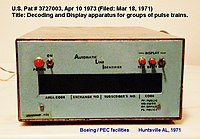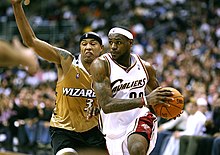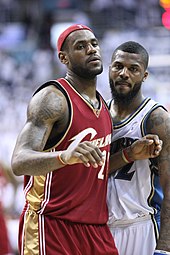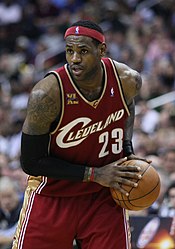Recent technological developments
- In 2013, the Fairphone company launched its first "socially ethical" smartphone at the London Design Festival to address concerns regarding the sourcing of materials in the manufacturing.[28]
- In late 2013, QSAlpha commenced production of a smartphone designed entirely around security, encryption and identity protection.[29]
- In December 2013, the world's first curved-OLED technology smartphones were introduced to the retail market with the sale of the Samsung Galaxy Round and LG G Flex models.[30] Samsung phones with more bends and folds in the screens were expected in 2014.[31]
- In early 2014, smartphones were beginning to use Quad HD (2K) 2560x1440 on 5.5" screens with up to 534 ppi on devices such as the LG G3 which is a significant improvement over Apple's Retina Display. Quad HD is used in advanced televisions and computer monitors, but with 110 ppi or less on such larger displays.[32]
- As of 2014, Wi-Fi networks were much used for smartphones. As Wi-Fi becomes more prevalent and easier to connect to, Wi-Fi phones service will start to take off.[33][34][35]
- Smartphones are increasingly integrated with everyday uses. For instance, credit cards and mobile payments are integrated into smartphones where users can send cash payments through smartphone applications and SaaS platforms.[36] Recently, Apple Pay has picked up 34 new banks to the roster supporting their mobile payment platform, where merchants are rapidly adopting it.[37] Additionally, recent technological innovations are causing keys to be fused into the smartphones, where the smartphone act as a digital key and access badge for its users.[38]
- Since 2013, water and dustproofing have made their way into mainstream high end smartphones instead of specialty models with the Sony Xperia Z continuing through the Sony Xperia Z3 and with the Samsung Galaxy S5.[39]
- One problem with smartphone cameras is focusing on subject, but LG G3 has lasers to help focus.[40]
- Some smartphones can be categorized as high-end point-and-shoot cameras with large sensor up to 1" with 20megapixels and 4K video. Some can store their pictures in proprietary raw image format, but the Android (operating system) 5.0 lollipop serves open source RAW images.[41][42]
Future possible developments
- A clear thin layer of crystal glass can be added to small screens like watches and smartphones that make them solar powered. Smartphones could gain 15% more battery life during a typical day. The first smartphones using this technology should arrive in 2015. This screen can also work to receive Li-Fi signals and so can the smartphone camera.[43] The cost of these screens per smartphone is between $2 and $3, much cheaper than most new technology.[44]
- Foldable OLED smartphones could be as much as a decade away because of the cost of producing them. There is a relatively high failure rate when producing these screens. As little as a speck of dust can ruin a screen during production. Creating a battery that can be folded is another hurdle.[45]
- Modular smartphones are projected, in which users can remove and replace parts.
- Near future smartphones might not have a traditional battery as their sole source of power. Instead, they may pull energy from radio, television, cellular or Wi-Fi signals.[46]
Mobile operating systems
Main article: Mobile operating system
Android
Main article: Android (operating system)
Android is an open-source platform founded in October 2003 by Andy Rubin and backed by Google, along with major hardware and software developers (such as Intel, HTC, ARM, Motorola and Samsung) that form the Open Handset Alliance.[26][27] In October 2008, HTC released the HTC Dream, the first phone to use Android.[24][25] The software suite included on the phone consists of integration with Google's proprietary applications, such as Maps, Calendar, and Gmail, and a full HTML web browser. Android supports the execution of native applications and third-party apps which are available viaGoogle Play, which launched in October 2008 as Android Market. By Q4 2010, Android became the best-selling smartphone platform.[47]
iOS
Main article: iOS
iOS is a mobile operating system developed by Apple Inc. and distributed exclusively for Apple hardware. It is the operating system that powers the company's iDevices. In 2007, Apple introduced the iPhone, the first device to use iOS and one of the first smartphones to use a multi-touch interface. The iPhone was notable for its use of a large touchscreen for direct finger input as its main means of interaction, instead of a stylus, keyboard, or keypad as typical for smartphones at the time.[23] In 2008, Apple introduced the App Store, which allowed any iPhone to install third-party native applications. Featuring over 500 applications at launch,[48] the App Store eventually achieved 1 billion downloads in the first year, and 75 billion by mid-2014.[49][50] In January 2015, Apple announced that they have now sold one billion iOS devices.[51]
Windows Phone
Main article: Windows Phone
In 2010, Microsoft unveiled Windows Phone 7 with a User Interface inspired by Microsoft's "Metro Design Language", to replace Windows Mobile. Windows Phone 7 integrates with Microsoft services such as Microsoft SkyDrive, Office, Xbox and Bing, as well as non-Microsoft services such asFacebook, Twitter and Google accounts. This software platform runs the Microsoft Mobilesmartphones, and has received some positive reception from the technology press and been praised for its uniqueness and differentiation.[52][53][54] In 2012, Microsoft released Windows Phone 8, replacing its previously Windows CE-based architecture with one based on the Windows NT kernel with many components shared with Windows 8, allowing applications to be ported between the two platforms.
BlackBerry
Main article: BlackBerry
In 1999, RIM released its first BlackBerry devices, providing secure real-time push-email communications on wireless devices. Services such as BlackBerry Messenger provide the integration of all communications into a single inbox. In September 2012, RIM announced that the 200 millionth BlackBerry smartphone was shipped. As of September 2014, there are around 46 million active BlackBerry service subscribers.[55] Most recently, RIM has undergone a platform transition, changing its name to BlackBerry and making new devices on a new platform named "BlackBerry 10."[56]
Firefox OS
Main article: Firefox OS
Firefox OS (originally called the boot to gecko project) was demonstrated by Mozilla in February 2012. It was designed to have a complete community based alternative system for mobile devices, using open standards and HTML5 applications. The first commercially available Firefox OS phones were ZTE Open and Alcatel One Touch Fire. As of 2014 more companies have partnered with Mozilla including Panasonic (which is making a smart TV with Firefox OS) and Sony.[57]
Sailfish OS
Main article: Sailfish OS
The Sailfish OS is based on the Linux kernel and Mer.[58] Additionally Sailfish OS includes a partially or completelyproprietary multi-tasking user interface programmed by Jolla. This user interface differentiate Jolla smartphones from others.[59] Sailfish OS is intended to be a system made by many of the MeeGo team, which left Nokia to form Jolla, utilizing funding from Nokia's "Bridge" program which helps establish and support start-up companies formed by ex-Nokia employees.[60][61][62]
Tizen
Main article: Tizen
Tizen is a Linux-based operating system for devices, including smartphones, tablets, in-vehicle infotainment (IVI) devices, smart TVs, laptops and smart cameras. Tizen is a project within the Linux Foundation and is governed by a Technical Steering Group (TSG) composed of Samsung and Intel among others. In April 2014, Samsung released the Samsung Gear 2 and the Gear 2 Neo, running Tizen.[63] The Samsung Z1 is the first smartphone produced by Samsung; it was released in the Indian market on 14 January 2015.[64]
Ubuntu Touch
Main article: Ubuntu Touch
Ubuntu Touch (also known as Ubuntu Phone) is a mobile version of the Ubuntu operating system developed byCanonical UK Ltd and Ubuntu Community.[65] It is designed primarily for touchscreen mobile devices such as smartphones and tablet computers.
Discontinued mobile operating systems
Symbian
Main article: Symbian
Symbian was originally developed by Psion as EPOC32. It was the world's most widely used smartphone operating system until Q4 2010, though the platform never gained popularity or widespread awareness in the U.S., as it did in Europe and Asia. The first Symbian phone, the touchscreen Ericsson R380 Smartphone, was released in 2000,[66][67] and was the first device marketed as a "smartphone".[68] It combined a PDA with a mobile phone.[69] In February 2011, Nokia announced that it would replace Symbian with Windows Phone as the operating system on all of its future smartphones, with the platform getting abandoned throughout the following few years.[70]
Windows Mobile
Main article: Windows Mobile
Windows Mobile was based on the Windows CE kernel and first appeared as the Pocket PC 2000 operating system. Throughout its lifespan, the operating system was available in both touchscreen and non-touchscreen formats. It was supplied with a suite of applications developed with the Microsoft Windows API and was designed to have features and appearance somewhat similar to desktop versions of Windows. Third parties could develop software for Windows Mobile with no restrictions imposed by Microsoft. Software applications were eventually purchasable from Windows Marketplace for Mobile during the service's brief lifespan. Windows mobile was phased out in favor of Windows Phone.
Bada
Main article: Bada
The Bada operating system for smartphones was announced by Samsung in November 2009.[71][72] The first Bada-based phone was the Samsung Wave S8500, released in June 2010.[73][74][75] Samsung shipped 4.5 million phones running Bada in Q2 of 2011.[76] In 2013, Bada merged with a similar platform called Tizen.
Palm OS
Main article: Palm OS
In late 2001, Handspring launched the Springboard GSM phone module with limIn. In May 2002, Handspring released the Palm OS Treo 270 smartphone, that did not support Springboard, with both a touchscreen and a full keyboard. The Treo had wireless web browsing, email, calendar, a contact organizer and mobile third-party applications that could be downloaded or synced with a computer.[77] Handspring was purchased by Palm, Inc which released the Treo 600 and continued releasing Treo devices with a few Treo devices using Windows Mobile. After buying Palm in 2011, Hewlett-Packard (HP) discontinued its webOS smartphone and tablet production.[78]
webOS
webOS was from LG, although some parts are open source. webOS is a proprietary mobile operating system running on the Linux kernel, initially developed by Palm, which launched with the Palm Pre. After being acquired by HP, two phones (the Veer and the Pre 3) and a tablet (the TouchPad) running webOS were introduced in 2011. On August 18, 2011, HP announced that webOS hardware was to be discontinued[79] but would continue to support and update webOS software and develop the webOS ecosystem.[80] HP released webOS as open source under the name Open webOS, and plans to update it with additional features.[81] On February 25, 2013 HP announced the sale of WebOS to LG Electronics, who planned to use the operating system for its "smart" or Internet-connected TVs.
Application stores
Main article: List of digital distribution platforms for mobile devices
The introduction of Apple's App Store for the iPhone and iPod Touch in July 2008 popularized manufacturer-hosted online distribution for third-party applications (software, computer programs) focused on a single platform. Up until that point, smartphone application distribution depended on third-party sources providing applications for multiple platforms, such asGetJar, Handango, Handmark, and PocketGear.
Following the success of the App Store, other smartphone manufacturers launched application stores, such as Google's Android Market in October 2008 and RIM's BlackBerry App World in April 2009. In February 2014, 93% of mobile developers were targeting smartphones first for mobile app development.[82]
Display
Main article: Display device
One of the main characteristics of smartphones is their screen. It usually fills virtually almost the entire phone surface (about 70%); screen size usually defines the size of a smartphone. Usually have aspect ratio 4:3 or 16:9.
They are measured in diagonal inches, starting from 2.45 inches.[83] Phones with screens larger than 5.2 inches are called "phablets". Smartphones with screens over 4.5 inches commonly are moved around in the hand or used with both hands, since the average thumb cannot reach the entire screen surface. Types of screen include LCD, LED, OLED, AMOLED, IPSand others.
Smartphone usage
In the third quarter of 2012, one billion smartphones were in use worldwide.[84] Global smartphone sales surpassed the sales figures for features phones in early 2013.[85] As of 2013, 65 percent U.S. mobile consumers own smartphones.[86]The European mobile device market as of 2013 is 860 million.[87] In China, smartphones represented more than half of all handset shipments in the second quarter of 2012[88] and in 2014 there were 519.7 million smartphone users, with the number estimated to grow to 700 million by 2018.[89]
As of November 2011, 27% of all photographs were taken with camera-equipped smartphones.[90] A study conducted in September 2012 concluded that 4 out of 5 smartphone owners use the device to shop.[91] Another study conducted in June 2013 concluded that 56% of American adults now owned a smartphone of some kind. Android and iPhone owners account for half of the cell phone user population. Higher income adults and those under age 35 lead the way when it comes to smartphone ownership.[92]
Worldwide shipments of smartphones topped 1 billion units in 2013 (up 38% from 2012's 725 million) while comprising a 55% share of the mobile phone market in 2013 (up from 42% in 2012).[93]
By manufacturer
| Source | Date | Samsung | Apple Inc. | Huawei | Xiaomi | Lenovo | LG | Others | Reference |
|---|---|---|---|---|---|---|---|---|---|
| Gartner | Q3 2014 | 24.4% | 12.7% | 5.3% | 5.2% | 5.0 | N/A | 47.5% | [94] |
| IDC | Q3 2014 | 23.7% | 11.7% | N/A | 5.2% | 5.1% | 5.0% | 49.3% | [95] |
| IDC | Q2 2014 | 24.9% | 11.7% | 6.7% | N/A | 5.2% | 4.8% | 46.7% | [95] |
| Gartner | Q4 2013 | 29.5% | 17.8% | 5.7% | N/A | 4.6% | 4.5% | 37.9% | [96] |





















